I fathomed that there would a number of steps to follow for a successful flight experience. My trip to Zambia would involve multiple legs. My flight route, departing Toronto on October 6, would be as follows:
• Toronto to Frankfurt, Germany (overnight, on Lufthansa)
• Frankfurt to Johannesburg, South Africa (overnight, on Lufthansa)
• Johannesburg to Lusaka, Zambia (on SA Airlinks)
I would spend eight nights in Zambia before flying to Malawi, where I would spend two nights. Naturally, I was a bit anxious about this route, as I would be transiting through two countries to reach Zambia.
What did I need to do? Each country differs somewhat in its entry requirements. I knew that many countries demanded a negative PCR test result for entry. Some countries, such as Germany where I would transit, require either negative PCR test results or proof of full vaccination against Covid-19. For countries not requiring proof of vaccination, the requirement typically would be:
• Negative PCR results delivered within 72 hours of departure from point of origin OR
• Negative PCR results delivered within 72 hours of planned arrival in the destination
Zambia required the former option. I googled “travel PCR test Toronto” to find out about tests offered locally. LifeLabs was providing a PCR test specifically for travel. Called “FlyClear”, the test was available at various locations, including t a drug store close to my office. I completed an on-line PCR test booking form. In addition to my preferred test location, the form requested information on my flight details and travel destination. Based on Zambia’s requirements, the form calculated a window when I should take my PCR test so that results would be delivered within the proper window. In this specific case, the test results could take up to 24 hours to generate. My departure flight was on a Wednesday evening at 1820 hrs. I chose an appointment at 5 PM two days prior and paid on-line. I had to register my name as it appears in my passport.
I received my receipt along with a link to the requisition form to print and bring with me to Shoppers Drug Mart. I needed to bring my passport to the drug store as well, since staff would check my passport to ensure my name on the requisition was identical to that which would be printed on the results form. The test was very simple – a cotton swab was gently dabbed into one nostril at a time and that was all. It was not highly invasive and uncomfortable as I imagined it might be!
My results were delivered by email the next morning (Tuesday) just before 9 AM and my PCR results were negative. While I always travel with my iPhone and could easily present the test results in my e-mail, I printed two copies of my results just in case. I also printed off and completed health declaration forms that were required for transit or entry to South Africa and Zambia. Since I am fully vaccinated, I printed off a couple of copies of my vaccination certificates and kept these altogether in a folder. This would prove helpful (below).
A couple of days before my flight on Lufthansa, I received an update with the opportunity to upload travel documents on-line in advance. I assumed this meant the results of my negative PCR test. It turns out I could also upload my vaccination certificates, even though these were not required for travel to any of the countries along my route.
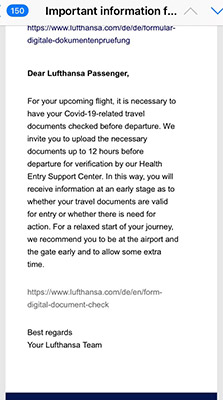
I received this e-mail from Lufthansa a few days prior to my flight.
While I appreciated the advance notice and followed the link, entering information about my final destination and other pertinent details, I was unable to complete the process after two attempts. I could not get my boarding passes and I assumed it was because I could not complete this process. Fortunately, this would not be a problem.
The next day, I arrived at Pearson International Airport three hours early to give myself plenty of time (Lufthansa had recommended at least 2.5 hours leeway). I had no baggage to check in, but knowing that I needed my boarding passes, I reported at the check-in desk (line-ups were almost negligible) The agent asked for my negative PCR test results here. The test results on my iPhone were indeed too small to be legible so the print-out version was good to have! I received printed tickets for all three flight legs from her.
That done, I proceeded through security and made my way to my gate. Come boarding time, the process was straightforward, and I simply presented my passport and boarding pass (you have to pull down your mask to let the gate agent see your face).
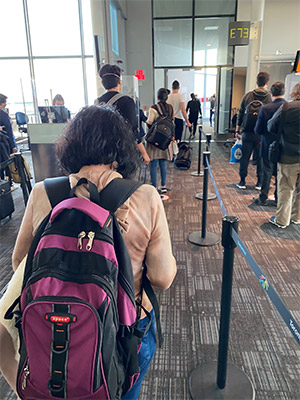
Boarding in Toronto was a simple affair.
Lufthansa didn’t board by zones for economy class, and yet the experience on board was a breeze! I had dinner on board; we must remain masked at all times except to eat. It was a comforting thought to know also had a negative PCR test result.
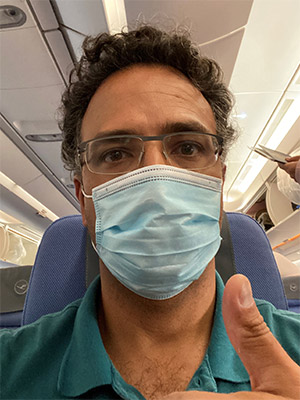
Universal masking is necessary inside airports and planes except while eating.
Arrived in Frankfurt the next morning, I needed to go through security to go from one wing of Frankfurt airport to the next for my flight to Johannesburg. Although I was not leaving the international area of the airport, I had to present my negative PCR test results at the security check while transferring from one wing to the next. Once again, it was good to keep these handy!
Frankfurt airport had physical distancing reminders at seating areas and every second seat in lounges was blocked off.
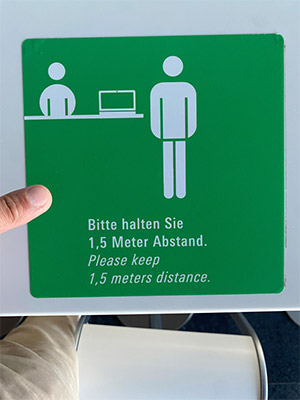
Reminders about physical distancing are thorough and ubiquitous in Frankfurt.
It was possible to eat in airport restaurants, but it was here that patrons need to show their proof of full vaccination. EU travellers seemed to have a QR code and restaurant servers were accustomed to that, but my printed Ontario provincial proof of vaccination was perfectly acceptable.
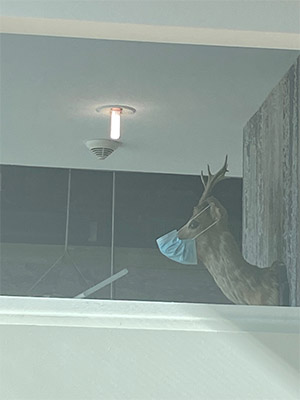
This taxidermied deer at the Frankfurt airport also wore a mask!
Upon reviewing my boarding pass to Johannesburg, I noticed that the boarding time was two hours prior to departure time. This surprised me initially because it seemed very early, but it turns out it was so that airline staff could do document check ahead with plenty of buffer time. Our gate was at the end of one wing of the airport. An announcement was made to direct us to the document check point, waiting in lines. Passport, boarding pass, and proof of vaccination were required. Thankfully, this early document check meant that the actual boarding process later was a breeze; all we had to do was to scan our boarding passes at an automatic gate - no further passport check required and a quick passage!
On the plane in the morning as we approached Johannesburg, crew offered us a South Africa Health declaration form. I already had mine complete.
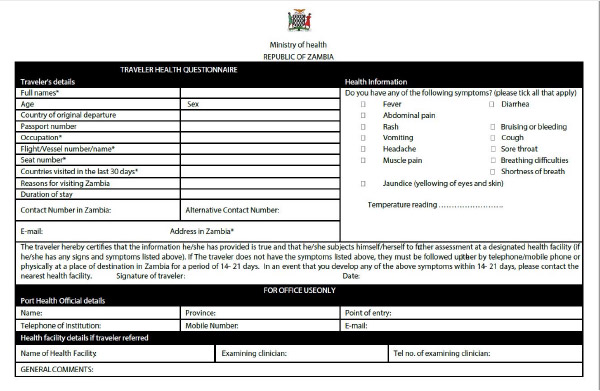
Most countries have a health declaration form that you may receive during each flight leg. Some can be downloaded in advance.
Upon arrival in Johannesburg, I had to pass from one terminal to another. Since I already had my boarding pass for Zambia and no checked luggage, I simply had to pass through a security check point where, as in Frankfurt, I had to present my boarding pass, passport, and negative PCR test results.
After transferring to the other terminal and upon boarding, I had to present my PCR test results once again. Finally upon reaching Zambia, I had to submit my Zambia health declaration form and pass through customs, and I was there! The process for entry to Malawi later would be similar, although I had to complete another PCR test on Day 6 in Zambia in order to enter Malawi since the results of my PCR test from Canada were no longer valid.
Generally speaking, the process for returning to Canada by multiple legs would be similar. In addition to presenting boarding pass and passport, having one’s current PCR test results handy is a requirement.
**And now, for the final return leg to Canada!
This was a tricky one for me. I had only two days in Malawi and while the PCR test I had in Zambia qualified me to board my flight all the way back through to Germany, the window of eligibility of that test would have expired for my Frankfurt–Toronto flight. PCR test results for must be within 72 hours of departure on the final, direct flight to Canada, not the departure at point of origin (in Malawi, in this case). I had two options:
1) Complete a PCR test in Malawi.
2) Complete a PCR test in Frankfurt with a test provider stationed at the airport.
Because I had several hours of layover in Frankfurt, the latter seemed a sensible approach rather than interrupting my time in Malawi while I had planned activities. Upon arrival in Frankfurt, I passed through EU customs to ‘enter’ Germany. The Departures Hall had a ‘COVID19 Test Centre’ where I did a PCR test.
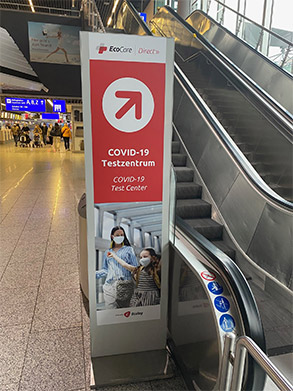
The Covid-19 test centre in the Frankfurt airport departures hall was well signed.
I waited about an hour for the results to be delivered by email, and then checked in with Lufthansa, showing the email with my negative result.
There is an additional step for re-entry to Canada. Under the Quarantine Act, travellers coming into Canada must demonstrate that they can undergo quarantine in Canada following arrival, if necessary. You can complete the questionnaire on the ArriveCAN app, which you can download to your phone or other device in advance.
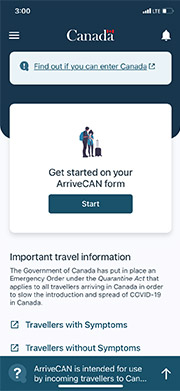
Completing the questionnaire in the ArriveCAN app is a requirement
for travellers to Canada.
In addition to completing the self-assessment questionnaire on ArriveCAN, you can upload your vaccination certificates there. This is where having your certificates in electronic form is handy. Upon completing your form in ArriveCAN, you will receive a receipt, which is essentially an alphanumeric code:
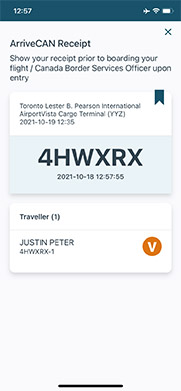
My ArriveCAN app receipt
So, at document check time, which in the case of my Frankfurt-Toronto flight, began about two hours prior just in front of the boarding gate, I had to produce the following:
1. Passport
2. Boarding pass
3. ArriveCAN app receipt on my phone
4. Negative PCR test result
And I was on my way home!
The landscape of entry requirements is evolving quickly. As I write, Air Canada has just partnered with SwitchHealthCA to provide take-along PCR tests; you can take a test kit with you to your destination and perform the self-swab test, obviating the need to use an in-country PCR test provider. The test result is accepted by Air Cananda for your homebound flight. I expect other carriers will introduce similar improved procedures.
As well, I have just learned that LifeLabs is now set up at Toronto’s Pearson International Airport to provide on-site rapid PCR test for outbound travel, meaning that those departing Canada from this airport could do their tests there without prior appointment, and with minimal delay.
When I started my trip, I knew what was required, but wasn’t quite sure how things would materialize in person. In transiting multiple airports to reach Zambia and Malawi, and to return to Canada, I concluded that it’s not difficult to make your travel process a peaceful one.
My recommendations:
1) Print copies of your latest/current negative PCR test results. The PCR test must be valid for travel. Have it handy on your electronic device as well. 2) Print copies of your vaccination record but also have it handy on your electronic device.
3) Expect there to be a document check process before every flight. On the first flight of a multi-flight trip, there may be document check at check-in. Document check could be somewhere in the wing of the airport where your gate is (if you are in transit). Or this could be just by the boarding gate. If you have not done a document check before a given flight, ask service staff from the airline.
4) Expect to fill in a health declaration form for each country you pass through, whether you are simply in transit, or whether it is your actual travel destination. You may download these in advance and complete to the extent possible. You may receive these aboard your flight too. It is possible you may not be asked for the completed form, notably where you are simply transiting. Best to complete the form anyways and be prepared.
You may receive reminders from your airline by e-mail with regards to document checks, from one to a few days prior to your flight. While it may be possible to complete document checks on-line, I personally prefer to do them in person.
You can count on Worldwide Quest to provide you with the very latest information on entry requirements to your destination country, and to assist you pertaining to your trip. If you have any questions, I invite you to write.
And now, onwards with travel!
P.S. I will tell you all about my familiarization tour in Zambia and Malawi before too long!



